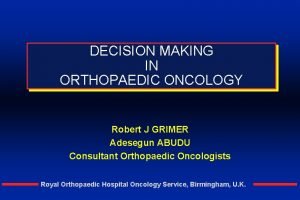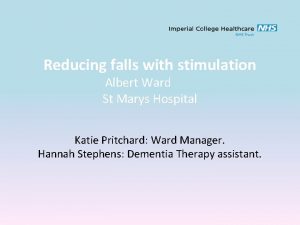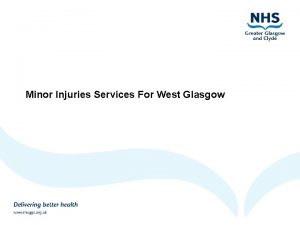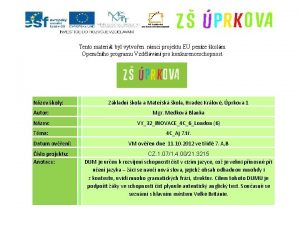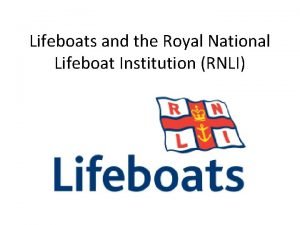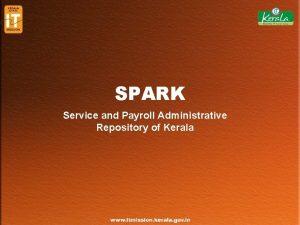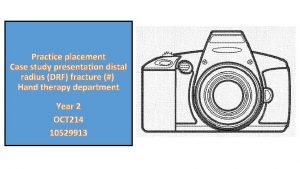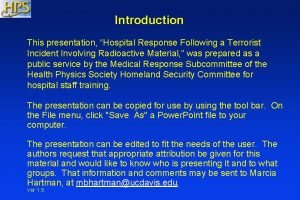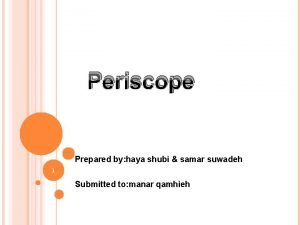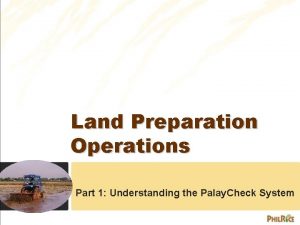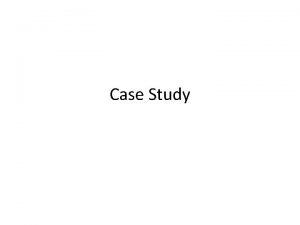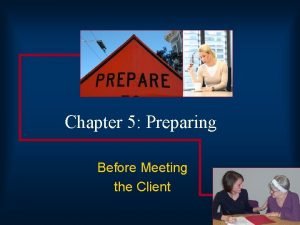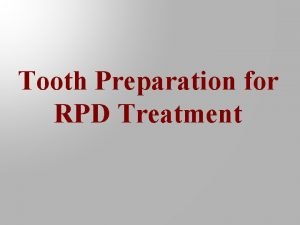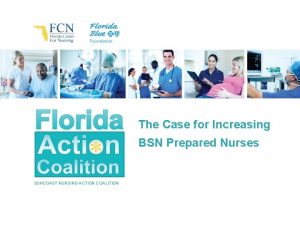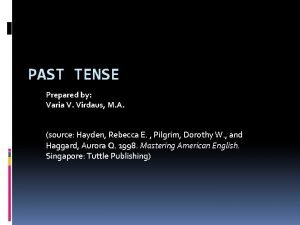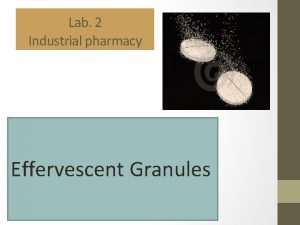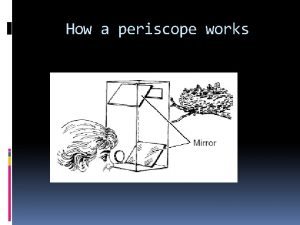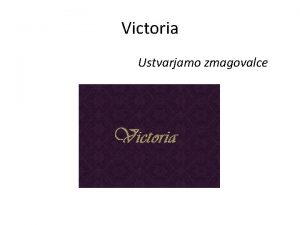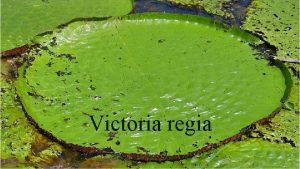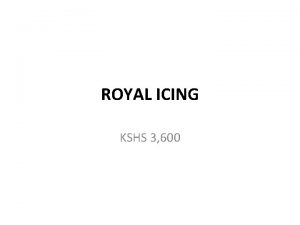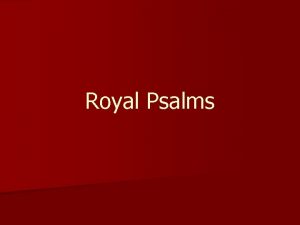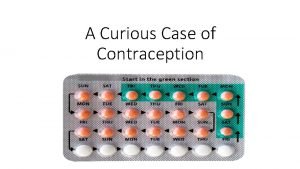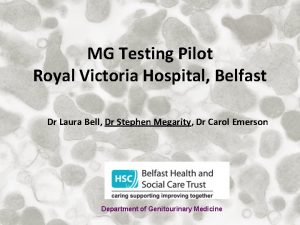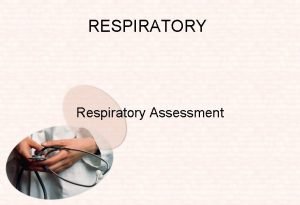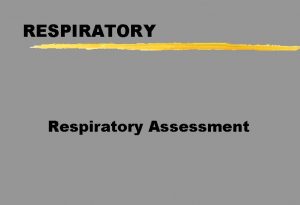Royal Victoria Hospital Respiratory Therapy Service Presentation prepared






































- Slides: 38

Royal Victoria Hospital Respiratory Therapy Service Presentation prepared by: Erin Monaghan RRT Topics: Section 1: Role of the Respiratory Therapist Section 2: Principals of Mechanical Ventilation

Section 1 : Role of the Respiratory Therapist Areas of Responsibility: b Adult Intensive Care Unit b Neonatal Intensive Care Unit b Main Emergency Room b M 5 Coronary Care Unit b Code Pink & Blue team (all Universal codes) b Respond to emergencies on wards. b Neonatal resuscitation post-delivery. b Bronchoscopy (Inpatient/Outpatient Procedures) b Research Projects (Liquid ventilaton, LOVS) b Inhaled Nitric Oxide Therapy

Section 1 : Role of the RT (cont’d) b b Specialize in clinical & technical aspects of Mechanical Ventilation, Airway management, Oxygen therapy, Aerosol therapy. RVH Board Certified to perform Intubations (Adult) Assist in the diagnosis (bronchoscopy) and treatment of patients with a variety of respiratory diseases and disorders. Assess and monitor patients in the critical care environment as well as during transport. (Adult & Neonatal) Specialized therapies: Nitric Oxide, Liquid ventilation, High. Frequency Ventilation (neonates), Surfactant replacement therapy. Specialized “”On-Call” Teams: Nitric Oxide, Liquid Ventilation.

Section 1 : Role of the RT (cont’d) The RT must be paged through locating (6111) for the following: b b b b All ventilator parameter changes. All VTR alarm conditions (that do not correct themselves). Apnea (and Apnea testing for Donors) Cardiac or Respiratory arrest. All patient transfers of mechanically ventilated patients within the hospital or exterior. Patients who require Nitric Oxide therapy, Liquid ventilation, LOVS. Bronchoscopy procedures (& percutaneous tracheostomy)

Section 2 : Mechanical Ventilation Abbreviations: b b b b VT: Tidal volume (mls) RR: Respiratory Rate (bpm) MV: Minute Volume = VT X RR (lpm)) Fi. O 2: Fraction of inspired Oxygen PEEP: Positive end expiratory pressure (cm. H 20) (I: E) Ratio : Ratio of inspiratory to expiratory time. Ti: Inspiratory time Flowrate: Speed of gas flow in liters per minute.

Definitions: Mechanical Ventilation Volume Ventilation: Pre-set Tidal volume will be delivered to the patient. Pressure Ventilation: Pre-set Inspiratory pressure will be delivered to the patient. b b Mandatory breaths: Breaths that the ventilator delivers to the patient at a set frequency, volume, flow. Spontaneous breaths: Patient initiated breath.

Definitions: (Cont’d) b b b Triggering: The sensitivity of the ventilator to the patient’s respiratory effort. Either flow or pressure setting that allows the ventilator to detect the patient’s inspiratory effort. Allows the ventilator to be in synchronization with the patient’s spontaneous respiratory efforts improving patient comfort during mechanical ventilation.

Factors that effect Ventilation: b Minute Ventilation = RR X VT b VT = 10 -12 ml / kg (IBW) RR = 10 -12 bpm (average) b b Pa. CO 2 = 35 -45 mm. Hg ETCO 2= 30 -43 mm. Hg p. H = 7. 35 -7. 45 ( 6 -10 lpm)

Factors that effect Oxygenation: FIO 2 b PEEP b Pa. O 2 target 80 -100 mm. Hg b Pa. O 2 / Fi. O 2 > 200 b Pulse Oximeter Saturation > 95 % oxygen toxicity : b a) can occur as early as 24 hours after high oxygen exposure b) more frequent if the Fi. O 2 is > 0. 5 c) clinically resembles adult respiratory distress syndrome d) very important to avoid since this often results in an inescapable vicious cycle of high oxygen requirements ultimately resulting in fatal respiratory failure.

Modes of Ventilation (most commonly used) A/C : Assist-Control SIMV / (PS) : Synchronized Intermittent Mandatory Ventilation (with Pressure-support) PSV: Pressure Support Ventilation. PCV: Pressure Control Ventilation. NIPPV : Non-invasive mechanical ventilation. CPAP: Continuous positive airway pressure. BIPAP: Bi-level positive airway pressure.

A/C : Assist-Control Ventilation Parameters set: b VT b RR b Fi. O 2 b PEEP b Flowrate b The ventilator will deliver the set VT for all mandatory and spontaneous breaths. The VTR assumes most/all of the work of breathing. Some patients may tend to hyperventilate on this mode.

A/C : (Cont’d) Background: ventilator provides full tidal volume at a minimum preset rate b additional full tidal volumes given if the patient initiates extra breaths Advantages: b provides near complete resting of ventilatory muscles b an be effectively used in awake, sedated, or paralyzed patients Disadvantages: b patients can hyperventilate and become alkalotic b patients can "stack" breaths (air trapping) and develop barotrauma b patients can develop "auto. PEEP" with barotrauma or hypotension b

SIMV / (PS): Synchronized Intermittent Mandatory Ventilation (with/without Pressure support) Parameters set: b VT (8 -12 ml/kg) b RR b Fi. O 2 b PEEP b PSV b Flowrate b Synchronized : the VTR will sets up a window of opportunity for the patient to trigger a breath spontaneously and if they don’t or the time window elapses a mandatory breath will be delivered. The mandatory rate set (at VT set) is guaranteed. Spontaneous breaths greater then the rate set can be supported with a pressure support to decrease the work of breathing imposed by the VTR, circuit, ETT.

SIMV / (PS): (Cont’d) Background: b ventilator provides set tidal volume at a preset rate b when a ventilator breath is programmed to occur, the ventilator waits a predetermined trigger period; any patient-initiated breath during this trigger period results in a programmed ventilator delivered breath the patient can take additional breaths but tidal volume of these extra breaths is dependent on the patient's inspiratory effort Advantages: b in theory, results in improved blood return to the right ventricle owing to intermittent negative pressure (spontaneous) breaths b patients often more comfortable since they have more control over their ventilatory pattern and minute ventilation Disadvantages: b can result in chronic respiratory fatigue if set rate is too low; in this situation, the following may be seen: b high respiratory rate b rising p. CO 2 b air trapping can occur

PSV: Pressure Support Ventilation. Initial settings: b set PS at the pressure required to generate VT of 8 -10 ml/kg (this will usually be about the same as the plateau pressure) b Fi. O 2 = 1. 0 b PEEP Spontaneous mode of ventilation. b Can be used alone or in combination with mandatory modes. Mode used to wean patients from VTR. b VT is variable, dependant on PS level set above PEEP, patient effort, chest compliance, resistance to flow.

PSV: (Cont’d) Background: b not a volume-cycled mode b when the patient triggers the ventilator, a set pressure (1 -100 cm) during the patient's inspiration; this air pressure is stopped when patient ceases to inspire. b tidal volume and minute ventilation are dependent on the patient Advantages: b avoids patient-ventilator aschrony b patients often more comfortable since they have full control over their ventilatory pattern and minute ventilation b often avoids breath stacking and auto. PEEP (especially in patients with COPD) b ability to permit self-determination of respiratory rate and to permit forced exhalation offers substantial advantages in status asthmaticus (Meduri, 1996) Disadvantages: b cannot be used in heavily sedated, paralyzed, or comatose patients b respiratory muscle fatigue can develop if the pressure support is set too low

PCV: Pressure Control Ventilation. Parameters set: (Mode: Either SIMV or A/C) b PC (Inspiratory pressure above PEEP) b PEEP b FIO 2 b RR & (I: E) Ratio & Ti

PCV: (Cont’d) Background: b the breath is pressure limited rather than volume limited b best reserved for patients with ARDS Advantages: b in ARDS, p. O 2 may increase 10 -15% Disadvantages: b there is no guaranteed tidal volume and thus there is no guaranteed minute ventilation b you must be very attentive to changes in the patients respiratory mechanics since unstable reactive airways disease can dramatically affect minute ventilation b air trapping can be a problem b CO 2 retention frequently occurs (although this may be acceptable in "permissive hypercapnia" strategies for ventilation of some patients with acute respiratory failure) b in general, patients must be heavily sedated since this is an uncomfortable mode for most patients

Whats the difference between PEEP & CPAP ? b PEEP is a term used for Positive end expiratory pressure delivered invasively via a mechanical ventilator to an intubated / tracheostomized patient during mechanical ventilation. b CPAP is a term used for the delivery of End expiratory pressure non-invasively via a face mask or nasal mask using a non-invasive ventilator device while the patient breaths spontaneously. (Respironics Vision or Respironics ST/D)

PEEP: Positive End Expiratory Pressure CPAP: Continuous positive airway pressure Initial settings: b b b b 5 cm is fairly standard and in many hospitals is used on most patients initially placed on the ventilator changes in PEEP may not be reflected by changes in arterial blood gases for 20 -30 minutes so changes in the PEEP setting should usually not be made faster than this the ventilator circuit should not be broken unless absolutely necessary; disconnecting the patient (for example, to transport him/her) can result in an immediate loss of the benefit of PEEP which can require 20 -30 minutes or more to restore PEEP is added in increments of 2 -5 cm until the "best PEEP" is obtained there is no optimal way to assess "best PEEP" some PEEP authorities choose the level which provides the highest static compliance (in other words, the lowest airway plateau pressure) in general, use the lowest amount which gives the desired effect on p. O 2 without lowering blood pressure, reducing cardiac output, or increasing the plateau pressure on the ventilator PEEP over 20 cm is rarely beneficial and usually results in additional pressureinduced lung injury

PEEP: (Cont’d) Background: ventilator provides a fixed positive airway pressure at the end of expiration b when used with assist-control ventilation, the term PEEP is used b when used with spontaneous breathing, the term CPAP (continuous positive airway pressure) is used Advantages: b opens closed alveolar units thus improving lung compliance and oxygenation b to a point, peak and plateau airway pressures actually decrease since there are more alveoli open at the beginning of inspiration b may improve secretion drainage from otherwise closed alveoli b can reduce right ventricular venous return and also lower left ventricular afterload b can be given on the ventilator or via a CPAP mask in the non-intubated patient Disadvantages: b barotrauma b can be risky and counterproductive in patients with obstructive airways disease b may worsen hypoxemia in patients with localized (as opposed to diffuse) lung disease (eg, pneumonia) b hypotension and reduced cardiac output b increased cardiac shunt (especially PFOs) b increased intracranial pressure b decreased renal perfusion b hepatic congestion b

Mechanical Ventilation “Standard VTR Parameters” b b b b Mode: SIMV / PSV VT : 8 -10 ml/kg (600 -700 mls on average) RR: 12 bpm Fi. O 2: 0. 5 PEEP: 5 cm. H 20 PSV: 10 cm. H 20 (I: E) Ratio: (1: >2) Flowrate 40 -60 lpm

NIPPV : Non-invasive mechanical ventilation. b b Mechanical ventilatory support delivered to the patient via face mask or nasal mask versus artificial airway. Modes: CPAP BIPAP (or Pressure-Support) Equipment: BIPAP VISION or BIPAP ST/D Mask cycled ventilation = using a conventional ICU ventilator non-invasively (by mask) with either PSV or A/C with PEEP.

BIPAP: Bi-level positive airway pressure. Parameters set: IPAP : Inspiratory positive airway pressure EPAP : Expiratory positive airway pressure. Back-up Rate : The unit will cycle from IPAP / EPAP a predetermined number of times per minute however does not guarantee a VT delivery. Fi. O 2: O 2 flow can be added to the circuit from an external source, in which case O 2 is diluted by the flow from the unit. (Fi. O 2 max + 0. 5) BIPAP Vision has an internal O 2 blender allowing Fi. O 2 1. 0

BIPAP: (cont’d) Indications: b chronic muscle dysfunction b ventilatory muscle fatigue b Hypoxemia despite FIO 2 0. 55 b post-extubation difficulty in whom you wish to avoid reintubation b upper airway obstruction due to laryngeal / supra or sub-glottic edema, b Sleep Apnea (Obstructive, Central)

BIPAP: (cont’d) CONTRAINDICATIONS & Relative Contraindications: b b b b Patients requiring high Fi. O 2 may not tolerate the BIPAP. Incapable of maintaining life sustaining ventilation in the event of malposition of the mask. BIPAP is a relatively contraindicated in patients with a full stomach or conditions that can result in delayed gastric emptying or regurg and vomiting. Full stomach or conditions that can result in delayed gastric emptying or regurg and vomiting. pre-existing bullbous lung disease represent a relative contraindication to PPV. Hypotension induced by Positive pressure ventilation. History of allergy or hypersensitivity to plastic or latex. (Face mask, nasal mask)

BIPAP: (cont’d) b COMPLICATIONS: The following is a list of some of the possible complications associated with the use of BIPAP: – – – Skin rash, breakdown on the nose or ears, cheeks Eye problems : Drying , Conjunctivitis Aspiration of stomach contents : Aspiration Pneumonia Pressure sores from the face mask or strap Tachypnea, SOB, anxiety and panic, claustrophobia

Weaning from Mechanical Ventilation: Factors to consider: b Awake, and off sedation (as much as possible). b Adequate nutrition, fluid status. b Free of infection. b Hemodynamically stable (preferably off pressors, angina controlled, no active bleeding) b Normal acid-base status b Bronchospasm controlled b Normal electrolyte balance b Oxygenation (O 2 requirements <0. 5 and PEEP <5 cm. H 20) Weaning Parameters: b RR/Vt <100 breaths/min /L b RR<30 b Vt >6 -8 ml/Kg

Causes of failure to wean: 1. Hypoxemia b Diffuse pulmonary disease b Focal pulmonary disease (Pneumonia) b Pulmonary edema (removal of positive pressure can increase preload and lead to worsening heart failure) 2. Insufficient Ventilatory Drive: b response to metabolic alkalosis b Inadequate function of CNS drive (Ex: sedatives, malnutrition) 3. Excessive Ventilatory Drive: b Excessive CO 2 production (sepsis, agitation, fever, high carbohydrate intake) 4. Respiratory Muscle Weakness: b Neuromuscular disease b Malnutrition b Drugs (Neuromuscular blocking agents, Corticosteroids, aminoglycosides)

Causes of failure to wean: (Cont’d) 5. Excessive Work of Breathing: b Airway obstruction b Bronchospasm b Secretions b Increased Raw (ETT) b ETT too small b Chest motion restriction (pain, bandages) 6. Acid base disorders 7. Phrenic nerve Injury (especially with contralateral pulmonary disease)

Troubleshooting: RULE OF THUMB: If your not sure if the Ventilator is working properly, you must manually ventilate the patient with the Ambu-bag & 100% O 2 until the RT is present.

Alarms & Troubleshooting: High Peak Inspiratory Pressure: b Secretions b Patient biting ETT b Patient coughing Low Pressure Alarm or low PEEP alarm: b Disconnect (check all connections) b Apnea (Servo B, C) Low Tidal Volume Spontaneous: b Circuit disconnect b Secretions

Complications associated with Mechanical ventilation: Ventilation-related complications: b Disconnection Malfunction b hemodynamic effects: a) decreased cardiac output due to impaired venous return to the right heart and increased pulmonary venous resistance due to positive pressure alveolar distension b) auto. PEEP b Barotrauma or Atelectasis b Oxygen toxicity b b b Respiratory alkalosis Increased intracranial pressure

Complications associated with Mechanical ventilation: (Cont’d) b b b Suctioning-related complications: Hypoxemia a) patients should always be pre-oxygenated with 100% oxygen prior to suctioning b) suction time should be limited Arrhythmias Nosocomial infections

Lung Compliance & Resistance & Auto-Peep The RT do these measurements on A/C mode, Square flow waveform and 60 lpm flow. b The patient must not be triggering the VTR with every breath. b Some patients may require sedation/paralysis for these measurements to be accurate. Lung Compliance: (Normal for VTR patient : Change in volume per cm. H 20 change in pressure. VT(Exhaled) Plateau - Peep b

Lung Compliance b b b b Compliance of the lung is defined as the volume change per unit of pressure change. Tissue elastic forces and surface tension impede inflation of the lung. Compliance measures the opposition of the lung to inflation. Elastance is the property of resisting deformation. Compliance represents the ease with which a body stretches, or its distensibility. Compliance = 1 Elastance Compliance (Lung) = Change in Volume Change in Pressure Normal Compliance of the Adult lung averages 0. 2 l/cm. H 20 60 to 90 m. L/cm H 2 O in the mechanically ventilated patients.

Resistance: RAW b b Normal value for Artificial Airway 6 -8 cm. H 20/L/sec RAW = PIP - Plat FLOW lps Airway Resistance is a product of the frictional forces associated with ventilation. Those forces are due to the anatomical structure of the airways and the resistance of the lungs and adjacent tissues and organs, rib cage, and diaphragm. However, it is airway resistance that is evaluated during mechanical ventilation. b Airway Resistance depends on four major factors; gas viscosity, gas density, the length and diameter of the airways, and the flow rate of gas through the tube. The two most important factors for therapist however are airway diameter and gas flow. b RAW across the ETT can also be measured. (RAWdistal-Raw Proximal)

Auto-Peep AKA: Intrinsic-PEEP or Air trapping Effects: b Flattend the diaphragm, impares respiratory muscle function thus reducing the patient’s ability to assume the respiratory workload. b The patient must also generate a larger then normal pressure differential to trigger an inspiratory breath. Techniques to minimize Auto-Peep: b Decrease airflow obstruction: Aggressive bronchodilation, secretion clearance. b Minimize Insp time increase Insp. Flowrate, prolong Exp time b Decrease VT, RR & Permissive hypercapnia b Apply PEEP to match level of autopeep.
 Habitos de la victoria privada
Habitos de la victoria privada Conducting zone of the respiratory system function
Conducting zone of the respiratory system function Royal surrey hospital buses
Royal surrey hospital buses Professor abudu royal orthopaedic hospital
Professor abudu royal orthopaedic hospital Albert ward st marys
Albert ward st marys Minor injuries unit stobhill
Minor injuries unit stobhill Magic box respiratory therapy
Magic box respiratory therapy Nottingham city hospital respiratory assessment unit
Nottingham city hospital respiratory assessment unit Queen victoria presentation
Queen victoria presentation Both psychoanalysis and humanistic therapy stress
Both psychoanalysis and humanistic therapy stress Bioness integrated therapy system price
Bioness integrated therapy system price Psychoanalytic therapy is to as humanistic therapy is to
Psychoanalytic therapy is to as humanistic therapy is to What types of lifeboat are there
What types of lifeboat are there Hospital pharmacy organization
Hospital pharmacy organization Spark service payroll and administration
Spark service payroll and administration Creek 2003 occupational therapy process
Creek 2003 occupational therapy process Hospital introduction presentation
Hospital introduction presentation The business plan should be prepared by
The business plan should be prepared by Two node loop instability
Two node loop instability Dramatic irony in act 4 of romeo and juliet
Dramatic irony in act 4 of romeo and juliet How is periscope prepared
How is periscope prepared Highlighting shampoo colors are prepared by combining
Highlighting shampoo colors are prepared by combining Wetland preparation
Wetland preparation Departmental accounts are prepared to ascertain
Departmental accounts are prepared to ascertain Business of making and serving prepared food and drink.
Business of making and serving prepared food and drink. Charred document example
Charred document example Wilson company prepared the following preliminary budget
Wilson company prepared the following preliminary budget Are you prepared for the zombie apocalypse
Are you prepared for the zombie apocalypse Seamus heaney storm on the island
Seamus heaney storm on the island The monophasic liquid prepared with
The monophasic liquid prepared with Preparatory reviewing
Preparatory reviewing Be prepared to give an answer
Be prepared to give an answer Always be ready to give an answer
Always be ready to give an answer Cingulum rest seat preparation
Cingulum rest seat preparation Benefits of bsn-prepared nurses
Benefits of bsn-prepared nurses Past form of prepared
Past form of prepared Preparation of effervescent granules
Preparation of effervescent granules Example of textual sermon
Example of textual sermon How a periscope works
How a periscope works



